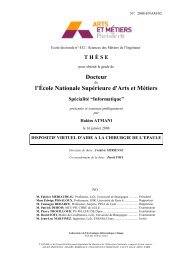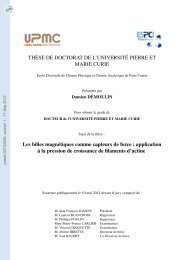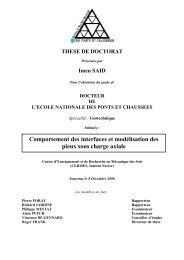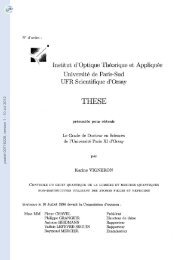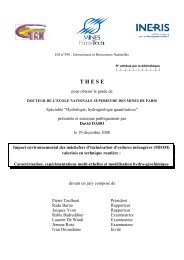Etude numérique de la fissuration d'un milieu viscoélastique - Pastel
Etude numérique de la fissuration d'un milieu viscoélastique - Pastel
Etude numérique de la fissuration d'un milieu viscoélastique - Pastel
Create successful ePaper yourself
Turn your PDF publications into a flip-book with our unique Google optimized e-Paper software.
G(z) = (z − b) 1/2 (z − c) 1/2<br />
P(z) est un polynôme <strong>de</strong> <strong>de</strong>gré fini.<br />
Les conditions aux limites donnent :<br />
ce qui permet <strong>de</strong> déterminer P(z) :<br />
3.2. Expression analytique du facteur d’intensité <strong>de</strong> contrainte<br />
4ℜ p ′ (z) − s ′ (z) <br />
|z|→∞ = σ∞y + σ∞x (3.32)<br />
4ℜ[s ′ (x)]|z|→∞ = σ ∞ y − σ∞x (3.33)<br />
P(z) = σ∞y 2 z + a0, s ′ (z) = σ∞y − σ∞x 4<br />
d’où a0 est déterminé à partir <strong>de</strong> <strong>la</strong> condition <strong>de</strong> fermeture <strong>de</strong> fissure aux <strong>de</strong>ux extrémités.<br />
On peut donc récrire l’équation (3.28) sous forme d’intégration suivante :<br />
Soit encore :<br />
2µ[v+(c) − v+(b)] =<br />
=<br />
=<br />
(3.34)<br />
<br />
2<br />
1 − k2 ℑp+(x) − 2k2<br />
c<br />
ℑs(x)<br />
1 − k2 b<br />
<br />
2 P(x)<br />
ℑ −<br />
1 − k2 G(x)<br />
2k2<br />
∞ σy − σ<br />
ℑ<br />
1 − k2 ∞ c<br />
x<br />
4 b<br />
2<br />
1 − k2 c σ∞ y x/2 + a0<br />
d x = 0 (3.35)<br />
(x − b)(c − x)<br />
b<br />
b + c<br />
a0 = −<br />
4 σ∞y (3.36)<br />
La contrainte normale et le gradient <strong>de</strong> dép<strong>la</strong>cement dans le p<strong>la</strong>n symétrique sont ensuite déterminés<br />
:<br />
σy = 2ℜp ′ <br />
1 1 c σ<br />
(x) = ± <br />
(x − b)(x − c) π b<br />
0 y (ξ) (ξ − b)(c − ξ)<br />
dξ + σ<br />
ξ − x<br />
∞ <br />
y [x − (b + c)/2] (3.37)<br />
∂v+<br />
∂x<br />
1<br />
= −<br />
2(1 − k2 )µ (x − b)(c − x)<br />
<br />
1<br />
π<br />
c σ0 y<br />
b<br />
(ξ − b)(c − ξ)<br />
ξ − x<br />
avec le signe supérieur pour x > c et le signe inférieur pour x < b.<br />
dξ + σ ∞ y<br />
Le facteur d’intensité <strong>de</strong> contrainte à x = b est :<br />
K (b)<br />
I =<br />
=<br />
<br />
lim 2π(b − x)σy (x)<br />
x→b−0<br />
<br />
2π 1 c<br />
−<br />
σ<br />
c − b π b<br />
0 y (ξ)<br />
<br />
c − ξ<br />
ξ − b dξ + σ∞ <br />
b − c<br />
y<br />
2<br />
En posant a = (c − b)/2 <strong>la</strong> <strong>de</strong>mi-longueur <strong>de</strong> <strong>la</strong> fissure, on obtient :<br />
K (b)<br />
= σ I ∞ 1<br />
y πa − πa<br />
c<br />
σ<br />
b<br />
0 y (ξ)<br />
[x − (b + c)/2]<br />
<br />
(3.38)<br />
(3.39)<br />
<br />
c − ξ<br />
dξ (3.40)<br />
ξ − b<br />
57




